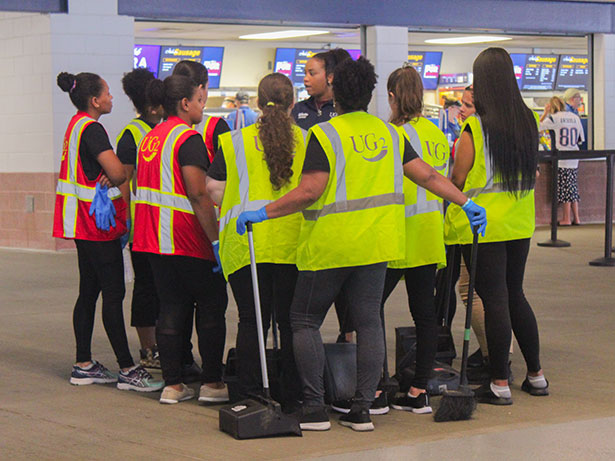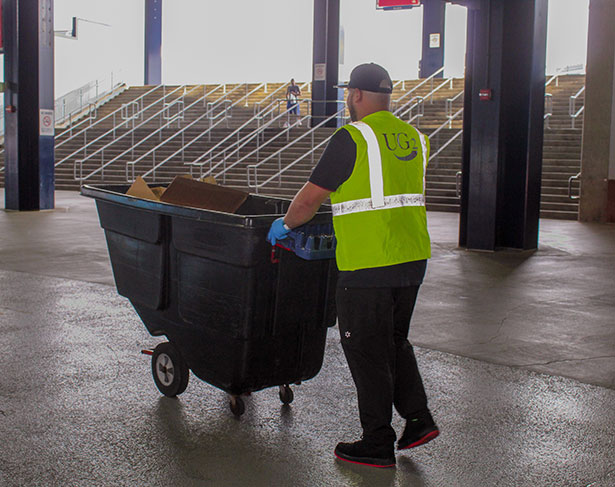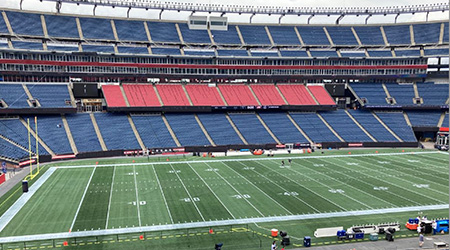SPONSORED
UG2 - Branded Feature
The 3 A's: Facility Services Playbook for Public Venues & Stadiums
by Greg Lanzillo, Senior Director, Operations, UG2
It’s often said that the only constant in facility services is change. Nowhere is this truer than for high-traffic stadiums and entertainment venues. With diverse events scheduled around the clock and attended by thousands – or tens of thousands – of people who enter, experience premium entertainment, and leave in a matter of hours, public venues pose unique challenges for facility maintenance professionals.
To consistently deliver the highest-quality facility services, you must excel in the three A’s: Adaptability, Attention to detail, and being Always-on.
Adaptability: The Show Must Go On
If there was one word to describe public venue facility services, it would be “unpredictable.” These venues are living, breathing facilities. The events they hold and the people they attract change daily. And even though facility teams have a framework and schedule of what should happen when and where, not everything can be set in stone. New elements pop up, requiring constant pivots and a keen ability to adapt.
- Weather makes a huge impact. If it’s snowing or raining, some attendees will arrive early to avoid traffic. Others will be late because of the poor weather conditions. How late or early is hard to predict, but entry times will surely be elongated, requiring staff to be at gates longer. They will also need to lay more mats, have more people to mop up hazards and deploy wet floor signage.
- HVAC systems are also affected. Since doors will be open longer, you have to expand the window for heating and cooling at entry points, depending on the temperature. Of course, the impact of adverse weather is exacerbated with open-air venues.
- Demographics also play a role in resource and supply allocation. Family-oriented events tend to generate a lot more consumption of food and beverages. Popcorn spreads like confetti throughout the venue and soda can etch floors if not cleaned up quickly and properly. These events also generate more trash resulting in more frequent pick-ups and deployment of more barrels to empty. Prime-time sports events may have more of a drinking crowd, with more foot traffic at bars and spills to clean up. When games are one sided, people leave early, which means shifting staff to gates sooner.
- Emergencies are a given with high-traffic venues. For example, backed-up toilets and flooding in restrooms must be attended to immediately and may require directing patrons to other bathrooms, which will then get even more use. Similarly, if an entrance heater breaks down, you need to quickly redirect and dispatch people to another gate while others work on the fix.
Being adaptable requires a show-must-go-on, all-hands-on-deck mindset. Facility services supervisors and managers must continually be in radio and chat contact with security, guest services, food and beverage, and maintenance staff before, during, and after events. They must constantly monitor and walk the floor.
Best practices for adaptability:
- Cross-train staff, so you can redeploy them to handle emergencies and prioritize safety and comfort for all.
- Plan for call-outs. Expect 90% of your crew to show up, and always have reliable staff that you can contact an hour before an event to come in on their day off, to replace no-shows and scale for last-minute requirements and inclement weather.
- Recognize that no single event is the same. Even the same concert or game will draw different crowds on weekends than weekdays. Daytime versus nighttime crowds can also vary. You must understand the dynamics of each in order to allocate the right resources to the right places.
- Plan with multiple shifts. Many maintenance staff work several jobs and have limited available hours. The people who have more availability may burn out if they do too many shifts in a row. The best practice is to have different crews for set up, event duration, and post-event clean up.
- Be opportunistic about deep cleaning and preventative maintenance. Allot specific times during off-event hours for short-term, high priority projects so you maintain quality in client facing and guest experience areas. It’s helpful to plan for time-consuming projects that can be done opportunistically when there is a day or two between events. The short-term solutions include restroom scrubbing, spot cleaning carpets, buffing floors near entrance gates and glass in VIP areas. The latter projects may include full carpet cleaning to allow time for drying, and pressure washing the concrete and scrubbing the seats in the venue’s “bowl” area.

Attention to Detail: Little Things Add Up
When people come to your venue as guests, workers, VIPs or entertainers, they expect to find a clean, comfortable, actively policed, and safe facility. Delivering an exceptional experience is a must, from the moment they enter, to when they take their seats, visit the locker room, go to their office, eat at a restaurant, or take advantage of other amenities.
But with public venues used 24x7x365 by thousands of people, there are endless places for dirt to accumulate; countless times when things like trash bins and chairs aren’t where they should be; and numerous opportunities for hand towel, disinfectant, and soap dispensers to be broken.
All of these, and more, must be addressed by maintenance teams before guests, venue employees, and VIPs discover them.
Tips for making sure things don’t fall through the cracks:
- Be guided by the patron experience. View your venue through their lens. Ask yourself how your customers would feel if they saw what you’re seeing as you walk the floors. Be on the lookout for anything that falls short or is missing, and make sure you communicate with the right people to address it.
- Double down on cleaning hard-to-reach places. A lot of post-event cleaning takes place at night when buildings that adhere to green power-saving guidelines aren’t as brightly lit. This makes it easier to miss things. During the day when it’s bright, get under seats and tables, clean in between crevices, wipe off the handprints and streaks on glass, and take another pass at vacuuming soft seating like couches.
- Leverage technology innovations such as sensors in paper towel and disinfectant dispensers to determine when areas like bathrooms and concession stands get higher levels of traffic and, therefore, require supplies to be restocked and areas to be recleaned.
- Assign tiers to janitorial tasks based on space and time considerations. For instance, Tier 1 may include locker rooms where earlier cleaning is needed, as teams have heightened expectations of the facilities they use, and talent is on the premises almost 24/7. Tier 2 may be for executive and premier guest areas since they often arrive earlier than other spectators. Tier 3 would be for all other spectators, and Tier 4 for the back of the house, which gets less traffic but is still important to keep clean.
- Focus on smooth hand-offs between supervisors on different shifts. Use a tag-out system and a fail-safe means for communicating what still needs to be addressed and validating that it did, such as Microsoft Teams, Slack or WhatsApp.

Always-on: The Spotlight is Shining
Facility maintenance staff are one of the main public faces of your venue. They must understand that when they're on the job, there’s no real downtime. Whether attending to a task or walking to one, they are always visible.
For one thing, cameras are just about everywhere. Not only do the venues themselves have cameras mounted throughout their facility, but the media are often in attendance, capturing the event and the people around it. And let’s not forget the guests who are eager to populate TikTok, Instagram, Facebook, Twitter and more with the great and not-so-great things they come across.
Additionally, because these staff are in uniform, they are also magnets for guests who have questions about – and expect answers to – everything from directions to bathrooms, bars, and first aid stations, to help changing their seats and retrieving personal items that fall through crevices.
To ensure your team provides a great experience for guests, above and beyond cleaning and maintenance:
- Define what professionalism means for your venue. For instance, workers can’t snap pictures of players or fraternize with them. They can’t use their personal phones or take cigarette breaks in plain view. Their uniforms must be clean with name tags visible.
- Provide ongoing customer service training and daily validations about the event on hand. Be clear on what you expect from their interactions with patrons. If staff speak English as a second language and struggle to communicate with guests, make sure they know to bring patrons to a supervisor who can help. If there’s an event with a large out-of-state or international presence expected, remind staff right before their shift how to help guests navigate throughout the building.
- Describe how to handle radio call-ins. Make sure staff know when, how and to whom to direct guests to for every type of question that may come up.
- Provide regular training for emergencies such as floods, fire drills, and critical out of scope situations.
High-traffic public venues are inherently challenging for facility services teams. But with the right preparation, an “all-hands-on-deck” mindset, and a customer-centric lens, you can deliver the wonderfully memorable experience that all patrons deserve.
Greg Lanzillo oversees day-to-day janitorial operations for UG2’s event-driven, commercial office, and corporate clients in New England. His focus on understanding the nuances of clients’ business goals and operations, and on building strong relationships with customers and staff alike, enables UG2 to deliver superior facility services. Since joining UG2 in 2013, Greg has risen through the ranks, concentrating on everything from operations support and site-level process improvement through increasing levels of operations management. Greg earned a BA in History with a minor in Economics from Tufts University and is a member of BOMA’s Emerging Professionals Committee.










